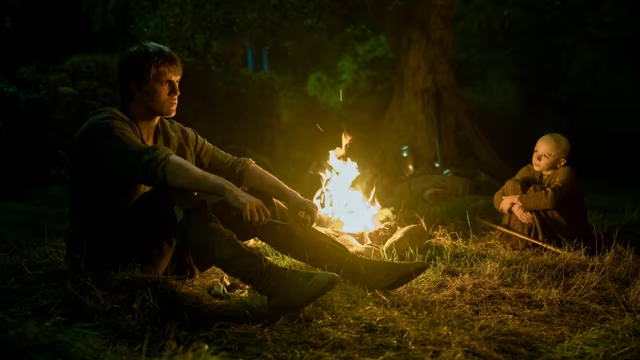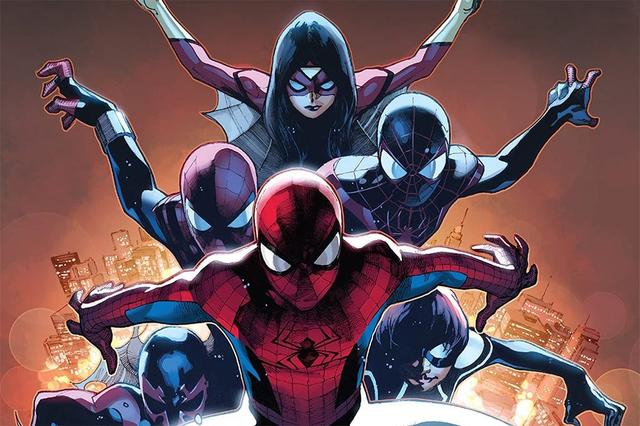If you click on a link and make a purchase we may receive a small commission. Read our editorial policy.
How to watch every Superman movie and TV series in order – from George Reeves to David Corenswet
DC's Man of Steel has never been more visible in pop culture thanks to the success of James Gunn's Superman movie with David Corenswet

Popverse's top stories
- The Hobbit crew from Lord of the Rings see each other "eight times a year," and Ian McKellen feels left out
- Don’t trust the 2026 release dates for GTA 6, Wolverine, or Elder Scrolls 6 [Gamify My Life]
- DC brings back the younger Jon Kent in a 2010s-Style Superman Unlimited this April
As the flagship superhero of DC Comics, Superman is second only to Batman for the number of live-action appearances in television and film across his 85-year history. There are dozens of films and TV series based on the character, with multiple actors stepping into the iconic cape and tights. Trying to follow the history of Superman in order on the big and small screens is tougher than leaping over a building in a single bound.
Fortunately, we've got our Superman watch order to help you keep track. Going all the way back to 1948 and including all the attempts to build a shared DC Universe in movies and shows, including James Gunn's 2025 film, Superman, this is everything you need to know to watch every movie starring Superman in order.
Superman watch order for every movie (and TV series too!)

Superman has had live-action depictions for 75 years, dating back to Kirk Alyn starring in a 1948 movie serial simply titled Superman. After a second Alyn-starring sequel, George Reeves took on the mantle of the Man of Steel for the 1951 feature film Superman and the Mole Men, which led to the successful Adventures of Superman television series the following year. After Reeves’ death and the end of the series, Superman’s live-action legacy lay dormant for nearly 20 years.
After the television broadcast of the admittedly bizarre musical It’s a Bird… It’s a Plane… It’s Superman in 1975, starring David Wilson as Superman, Christopher Reeve claims the role for a series of four films starting in 1978. Universally praised for his performance, Reeve steps away from the role in 1987, with Superman’s live-action projects shifting to television for nearly 20 years. After Brandon Routh’s cinematic turn as the Man of Tomorrow in 2006’s Superman Returns, Henry Cavill inherited the role for the DCEU, starting with 2013’s Man of Steel before ending his run with 2022’s Black Adam. That is followed by our current era, with David Corenswet in 2025's Superman and beyond.
Beyond his more prominent appearances, Superman has appeared in live-action in a silent, faceless cameo capacity in television projects, including the first season finale of Peacemaker and the series finale of the Max original series Titans.
Here are all the Superman movies & TV series in order:
- Superman (1948)
- Atom Man vs. Superman (1950)
- Superman and the Mole Men (1951)
- Adventures of Superman (1952-1958)
- It’s a Bird…It’s a Plane…It’s Superman (1975)
- Superman (1978)
- Superman II (1980)
- Superman III (1983)
- Superman IV: The Quest for Peace (1987)
- Superboy (1988-1992)
- Lois & Clark: The New Adventures of Superman (1993-1997)
- Smallville (2001-2011)
- Superman Returns (2006)
- Superman II: The Richard Donner Cut (2006)
- Man of Steel (2013)
- Supergirl (2015-2021)
- Batman v. Superman: Dawn of Justice (2016)
- Justice League (2017)
- Shazam! (2019)
- Zack Snyder’s Justice League (2021)
- Superman & Lois (2021-2024)
- Peacemaker (2022)
- Black Adam (2022)
- Titans (2023)
- The Flash (2023)
- Superman (2025)
- Supergirl: Woman of Tomorrow (2026)
- Man of Tomorrow (2027)
How to watch Superman in the correct order
When thinking about how to start the Superman series, I'd recommend you go with 1978's Superman. Don't let the year fool you; just as 1977's Star Wars has become timeless, Christopher Reeve's inaugural flight as DC's Man of Steel holds up surprisingly well - just forgive the rotary phones, and you'll be set.
Why are there two versions of Superman II and Justice League?

Superman has the rare distinction of appearing in two vastly different versions of the same movie that received a wide release after its initial theatrical run on two separate occasions – three occasions, if one includes the Batman v. Superman: Dawn of Justice Ultimate Edition. However, where as the content added to Batman v. Superman is additive, maintaining the broad strokes of the story and tone of the theatrical release, the alternate versions of Superman II and Justice League are considerably different than their respective theatrical release counterparts.
Director Richard Donner initially worked on Superman and Superman II simultaneously, before turning his primary focus to completing the first movie in time for its 1978 release. While approximately 75% of Superman II was completed by Donner, he was replaced by producer Richard Lester to complete the sequel. Lester retained much of Donner’s footage but significantly rewrote and re-filmed enough of the film to receive sole director credit. Over 25 years later, fueled by fan interest and the resolution of outstanding legal issues, Superman II: The Richard Donner Cut was released on home video, removing Lester’s comedic flourishes and restoring much of Donner’s originally intended vision of the film.
Similarly, original filmmaker Zack Snyder left production on Justice League, despite completing the majority of the movie. He was replaced by Marvel Studios veteran Joss Whedon, who overhauled the film though retained its core premise of the Justice League resurrecting Superman and fighting Steppenwolf. In the wake of intense fan campaigns and reports of behind-the-scenes difficulties following Snyder’s departure, Snyder returned to the project to release his original and greatly different version of the film in 2021 on Max as Zack Snyder’s Justice League.
Christopher Reeve Superman movies in order

The in-universe chronology of Reeve’s Superman films is relatively easy to follow, largely going by release date, with the 1978 film chronicling the destruction of Krypton and Clark Kent embracing his superhero destiny. The existence of two different versions of Superman II is the only wrinkle disrupting a clean timeline, though the Donner Cut doesn’t invalidate anything that occurs in Superman III or Superman IV, leaving it up to the viewer’s preference which to slot into the chronology.
The 1984 spinoff film Supergirl, starring Helen Slater as Superman’s cousin Kara Zor-El, is set in the same continuity as the Reeve Superman series, though Reeve himself is noticeably absent. Instead, a brief news broadcast explains that Superman is off-world on a mission in a different galaxy, though a poster of Superman can be seen in Linda Lee and Lucy Lane’s dorm room. Marc McClure reprises his role as Jimmy Olsen from Reeve’s films to make the connection with Supergirl more apparent.
Producers Alexander and Ilya Salkind went on to produce a live-action Superboy series in 1988, which ran for four seasons and starred John Haymes Newton and, in its final three seasons, Gerard Christopher as a young Clark Kent. Though the show retains much of the visual and thematic aesthetics as the Reeve films, it is in its own continuity with its significantly retooling of Superman’s backstory compared to the movies, including Clark meeting Lex Luthor much earlier in his life.
- Superman (1978)
- Superman II (1980)
- Superman II: The Richard Donner Cut (2006)
- Superman III (1983)
- Supergirl (1984)
- Superman IV: The Quest for Peace (1987)
How does Superman Returns figure into all of this?

2006’s Superman Returns is something of an anomaly, at once an attempt to continue Donner’s vision of the Man of Tomorrow and yet position the iconic hero for new audiences nearly two decades after Reeve vacated the role, with Brandon Routh playing the character. Filmmaker Bryan Singer describes Superman Returns as following the events of Superman II, effectively rendering Superman III and Superman IV non-canonical in this version of the story. There are references and direct quotes to the first two Reeve-starring Superman movies while Marlon Brando’s Jor-El appears through archival video and audio.
After plans for a sequel to Superman Returns were quietly shelved in light of the film not performing as well commercially as Warner Bros. had hoped, this iteration remained untouched for over a decade. The 2019 television crossover event Crisis on Infinite Earths brings in several fan-favorite DC shows and movies for the multiversal adventure in different capacities. Among the worlds explored is a universe where Routh portrays an older Superman who is haunted by the loss of his wife Lois to the Joker.
In addition to Routh’s reprisal of the role, he briefly mentions his son Jason, introduced in Superman Returns, and hints at experiencing the events of Superman III, implying some version of the 1983 film did occur in this continuity despite the obvious discrepancies, most notably involving Superman and Lois’ son.
How are Superman’s CW shows connected?

Interestingly enough, despite airing on the same television network, all three Superman-centric live-action series produced by The CW – Smallville, Supergirl, and Superman & Lois – each technically exist in their own distinct universes. That said, they all also share visible connections to one another, including a memorable crossover between the Smallville universe and the Arrowverse.
During the 2019 television crossover event 'Crisis on Infinite Earths,' the Superman and Lois Lane from the Arrowverse visit the Kent farm in the Smallville universe to warn this world’s Clark that their version of Lex Luthor is planning to murder him. Confronting Luthor alone, Clark is immune to Lex’s normally lethal supply of kryptonite, having voluntarily given up his powers to focus on raising his family with his wife Lois. This allows Clark to easily overpower Luthor, forcing the supervillain to retreat elsewhere in the multiverse to seek more vulnerable prey.
Though Superman & Lois initially appears to share a continuity with the Arrowverse, including appearances by Arrow series regular John Diggle and a photo of Kara Danvers, this is changed by the second season. In the second season finale, General Sam Lane claims that Superman is the only hero in this universe before clarifying he has peered into other universes where multiple superheroes exist. This places Superman & Lois outside of the Arrowverse proper, though Lane’s comments suggest he may have glimpsed the Arrowverse in his observation of the multiverse.
The CW's Superman in order

Each CW Superman show takes place roughly in the time of the respective releases, with Smallville starting at the beginning of the 21st century. By the time this universe is revisited during 'Crisis on Infinite Earths,' Clark Kent and Lois Lane are noticeably older and have daughters of their own. Similarly, one can assume Superman & Lois starts in the final years of the Arrowverse, albeit in a completely different universe.
- Smallville (2001-2011)
- Supergirl (2015-2021)
- Superman & Lois (2021-2024)
Henry Cavill Superman movies in order

So you might be asking yourself right now - 'How should I watch Henry Cavill Superman movies in order?' Well, the DCEU Superman has appeared in eight different DCEU projects, five of which played by Henry Cavill. Cavill's portrayal of the character kicks off the DCEU in 2013 with Man of Steel, providing a rebooted origin story of the superhero as he defends the world from General Zod. Batman v. Superman spins out of the consequences from Man of Steel while both versions of Justice League resurrect Superman to join a team of heroes opposing invaders from Apokolips.
Cavill’s final appearance as Superman takes place in the post-credits scene to Black Adam, with the hero reaching out to Adam at Amanda Waller’s behest. Though the DCEU Superman appears in Shazam! and Peacemaker, the character is silently played by body doubles Ryan Hadley and Brad Abramenko, respectively. The Flash contains several versions of Superman, constructed by CG, with George Reeves, Christopher Reeve, and Nicolas Cage – from the canceled 90’s film project Superman Lives – in glimpses across the multiverse.
If you were to ask me 'How many Superman movies are with Henry Cavill?' I would say three - Man of Steel, Batman v. Superman: Dawn of Justice, and the Justice League movie. He's appeared in other DCEU projects, but those are the core ones you're after.
- Man of Steel (2013)
- Batman v. Superman: Dawn of Justice (2016)
- Justice League (2017)
- Zack Snyder’s Justice League (2021)
- Shazam! (2019)
- Peacemaker (2022)
- Black Adam (2022)
- The Flash (2023)
Who can realistically beat Superman?
Superman is vulnerable to magic, kryptonite, and the effects of a red sun. Any villain who can wield one or a combination of those factors can give the Man of Steel a difficult time. That said, it's also worth noting that Doomsday straight up killed Superman back in the Death of Superman comic book storyline.
Is Superman 2025 a hit or flop?
Superman (2025) is a hit. It earned $616 million on a budget of $225 million. Variety reported that Superman brought in a profit of $125 million in for Warner Bros.
Why is Henry Cavill not Superman anymore?
That is the big question, really. After starring in multiple DCEU movies as Superman, it seemed that Henry Cavill's time as the Man of Steel was over after his brief appearance in Black Adam. Shortly after, it was confirmed that, no, we wouldn't be getting more Henry Cavill Superman movies.
The reason is that James Gunn was recasting most of the DC cast when he took over the franchise's overall direction. While John Cena is back as Peacemaker and a few other actors remained, the vast majority of the DCU was recast when Gunn took over DC Studios. That meant Cavill, despite being pretty good as Superman, was out in favor of the relatively unknown David Corenswet.
What are the next live-action Superman projects?

Supergirl: Woman of Tomorrow will be hitting theaters in the summer of 2026. And after that, a follow-up to the 2025 Superman film called Man of Tomorrow will be released in theaters in 2027. It will be written and directed by James Gunn, and will star David Corenswet and Nicholas Hoult.
James Gunn's Superman movie is out now - and we have a lot to say about it. You can also read about Superman's S-Shield through the ages, how Superman and Clark Kent keep their secret identity secret, our recs for best Superman comics, and how to watch all his TV series and movies in order.
Follow Popverse for upcoming event coverage and news
Find out how we conduct our review by reading our review policy
Let Popverse be your tour guide through the wilderness of pop culture
Sign in and let us help you find your new favorite thing.
















Comments
Want to join the discussion? Please activate your account first.
Visit Reedpop ID if you need to resend the confirmation email.